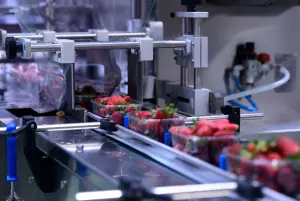Food processing facilities encounter a wide array of pest challenges every day. Each site presents unique concerns based on its location and the products it processes or manufactures. However, some pests are consistently problematic in food processing facilities. Read on to learn more.
Implementation of Risk-based Pest Control
 In 2015, the Food Safety Modernization Act (FSMA) implemented a stronger emphasis on risk-based preventive controls for food manufacturing facilities. This approach requires facilities to assess their specific risks, implement strategies to mitigate or eliminate those risks, verify their effectiveness, and make adjustments as necessary to maintain them. These measures, along with any associated actions, must be thoroughly documented in written records.
In 2015, the Food Safety Modernization Act (FSMA) implemented a stronger emphasis on risk-based preventive controls for food manufacturing facilities. This approach requires facilities to assess their specific risks, implement strategies to mitigate or eliminate those risks, verify their effectiveness, and make adjustments as necessary to maintain them. These measures, along with any associated actions, must be thoroughly documented in written records.
How does this relate to pest control? Identifying the unique pest risks at your facility allows you and your pest management provider to address problematic areas. Once you’ve found the issue, it’s much easier to implement strategies that prevent pest intrusion or manage infestations effectively. If you’ve observed signs of pest activity on your property, visit our service page to learn how we can help.
It’s also vital to regularly review risk-based plans to ensure they continue to be effective. Several factors can impact a facility’s pest control needs, such as:
- The introduction of new products, ingredients, equipment, suppliers, or processes that may increase risks.
- Renovations or construction projects that may require updated pest management measures.
- Extreme weather events, including floods, droughts, or hurricanes, which might necessitate temporary preventive controls.
Frequently Found Pests within Food Processing
Understanding the pest challenges faced by others in your industry can provide valuable insight and help you identify potential risks at your facility.
As you evaluate your pest management needs, this information can assist in refining your program to address the most threatening pest concerns. If you suspect that any of these pests might pose a problem at your facility, reach out to us before it’s too late.
1. Rodents
Rodents are the most common pest problem for food processors, with infestation rates rising across the country. Mouse populations are reaching unprecedented levels, and roof rats are expanding their range into new areas.
2. Night-Flying Insects (Moths and Other Nocturnal Pests)
These pests are frequently seen near loading docks and other locations that are frequently open. Installing insect light traps can help significantly reduce their presence in a facility.
3. House Flies
House flies are known carriers of diseases, posing a major risk to food processing operations. They can slip through small gaps and cracks, but insect light traps are an effective method for preventing their intrusion.
4. Small Flies and Gnats
This group includes pests such as phorid flies, fruit flies, and gnats. These insects thrive in damp environments or areas with organic debris; proper sanitation is essential to manage them.
5. Pigeons
Pigeons present a significant risk to food safety and public health by contaminating surfaces and products. A tailored pest control plan can help minimize pigeon activity around your facility.
6. Sparrows
These small birds often nest in structural crevices, typically roof overhangs, and can become problematic in loading docks or other entry points. Installing exclusion measures is an effective strategy to prevent their access.
7. Warehouse Beetles
Warehouse beetles target stored products, particularly grains, and thrive in areas where dust accumulates. Common troublesome areas include coating rooms, sifting areas, hammer mills, elevators, and other places with dust buildup, such as beams or electrical panels.
8. Indian Meal Moths
Indian meal moths are often seen resting on or flying near areas where dried foods are stored. They infest both raw materials and packaged goods, including rice, birdseed, cornmeal, chocolate, crackers, dog food, dried fruits, and whole wheat products. Virtually any dried food item can serve as a host for these pests.
9. Bottle and Flesh Flies
Both of these fly species exhibit similar habits and are commonly found near waste, rotting organic material, or animal byproducts in processing facilities.
10. Cigarette Beetles
Similar to warehouse beetles, cigarette beetles pose a significant issue in spaces where dried foods are handled and fine debris gathers. They are commonly found in milling, coating, and sifting areas, as well as in locations that house plant-based or animal-derived products and their residues.
As an RK Environments client, your pest management program is specifically designed to address the unique challenges and risks of your facility. During routine service visits, your assigned specialist carefully monitors for emerging pest issues or conditions that may encourage pest activity, documenting all findings in your Proof of Service Report.
If you’re not currently an RK Environments customer but are interested in discovering our customized pest control solutions for food processing facilities, reach out to us today to learn how we can assist you.






